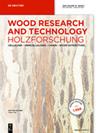An overview of lab-based micro computed tomography aided finite element modelling of wood and its current bottlenecks
IF 1.6
3区 农林科学
Q2 FORESTRY
引用次数: 0
Abstract
Abstract Microscopic lab-based X-ray computed tomography (XµCT) aided finite element (FE) modelling is a popular method with increasing nature within material science to predict local material properties of heterogeneous materials, e.g. elastic, hygroexpansion and diffusion. This method is relatively new to wood and lacks a clear methodology. Research intended to optimise the XµCT aided FE process often focuses on specific aspects within this process such as the XµCT scanning, segmentation or meshing, but not the entirety of the process. The compatibility and data transfer between aspects have not been investigated to the same extent, which creates errors that propagate and negatively impact the end results. In the current study, a methodology for the XµCT aided FE process of wood is suggested and its bottlenecks are identified based on a thorough literature review. Although the complexity of wood as a material makes it difficult to automate the XµCT aided FE process, the proposed methodology can assist in a more considered design and execution of this process. The main challenges that were identified include an automatic procedure to reconstruct the fibre orientation and to perform segmentation and meshing. A combined deep-learning segmentation method with geometry-based meshing can be suggested.基于实验室的微计算机断层扫描辅助木材有限元建模及其当前的瓶颈概述
基于实验室的微观X射线计算机断层扫描(XµCT)辅助有限元(FE)建模是一种在材料科学中越来越受欢迎的方法,用于预测非均质材料的局部材料特性,例如弹性、湿膨胀和扩散。这种方法相对较新,缺乏明确的方法。旨在优化XµCT辅助有限元过程的研究通常侧重于该过程中的特定方面,如XµCT扫描、分割或网格划分,而不是整个过程。方面之间的兼容性和数据传输没有得到相同程度的研究,这就产生了传播错误并对最终结果产生负面影响的错误。在目前的研究中,提出了一种XµCT辅助木材有限元过程的方法,并根据全面的文献综述确定了其瓶颈。尽管木材作为一种材料的复杂性使得XµCT辅助FE过程的自动化变得困难,但所提出的方法可以帮助更周到的设计和执行该过程。确定的主要挑战包括重建纤维方向的自动程序以及执行分割和网格划分。提出了一种结合深度学习和几何网格划分的分割方法。
本文章由计算机程序翻译,如有差异,请以英文原文为准。
求助全文
约1分钟内获得全文
求助全文
来源期刊

Holzforschung
工程技术-材料科学:纸与木材
CiteScore
4.60
自引率
4.20%
发文量
83
审稿时长
3.3 months
期刊介绍:
Holzforschung is an international scholarly journal that publishes cutting-edge research on the biology, chemistry, physics and technology of wood and wood components. High quality papers about biotechnology and tree genetics are also welcome. Rated year after year as one of the top scientific journals in the category of Pulp and Paper (ISI Journal Citation Index), Holzforschung represents innovative, high quality basic and applied research. The German title reflects the journal''s origins in a long scientific tradition, but all articles are published in English to stimulate and promote cooperation between experts all over the world. Ahead-of-print publishing ensures fastest possible knowledge transfer.
 求助内容:
求助内容: 应助结果提醒方式:
应助结果提醒方式:


